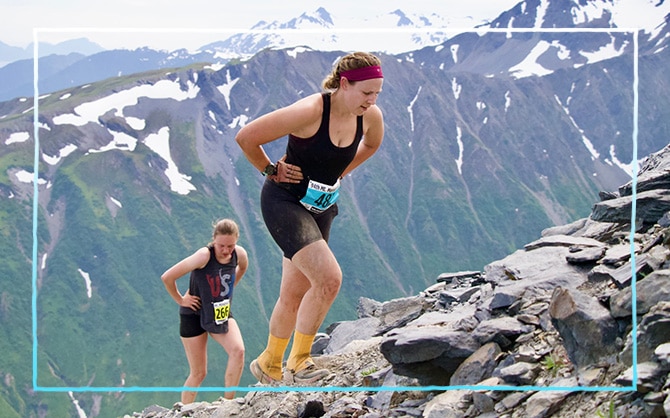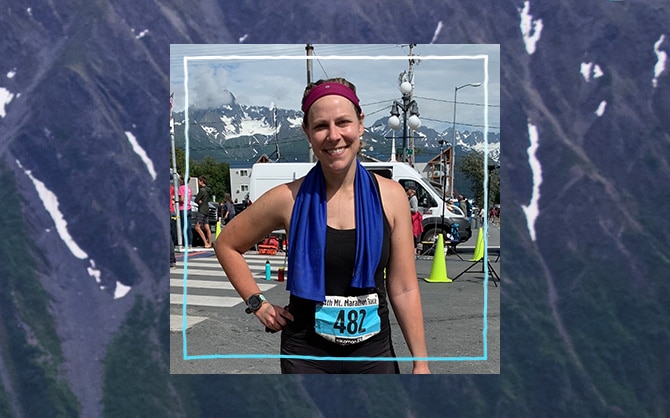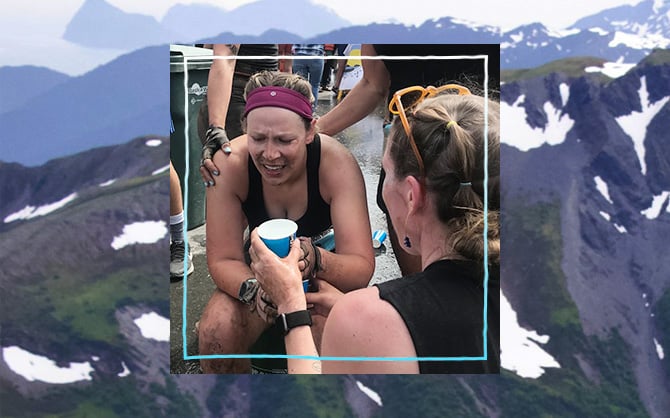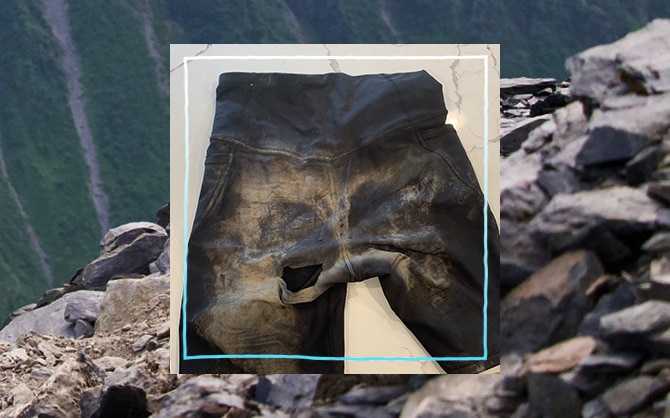A 3,022-foot runner’s high

“Strong tumble!”
a fellow runner yelled to me in support as I quickly recovered from a hard fall.
I continued on, barreling down a 64% grade. “Just keeping swimming,” I repeated to myself. This was the only thought I allowed to enter my head as I raced the legendary Mt. Marathon.
But before I go any further, let me explain what makes this 5K footrace so legendary — yes, it’s only a 5K.
The background
Mt. Marathon, also known as “the world’s toughest 5K”, is an annual race that takes place in the little port town of Seward, Alaska every Fourth of July. On the day of the race, the town’s population of nearly 3,000 swells up to 30,000 as people flock to see what is commonly referred to as “Alaska’s Superbowl.”
But there are no footballs involved. No prize money either. Just a few hundred crazy runners willing to sign up for a 3,022-foot race up and down an insanely steep mountain, featuring a mix of cliffs, waterfalls, slipperier than snot rocks, dust, roots, shale, and scree.
While the race has reached international popularity in recent years, Mt. Marathon is believed to be the oldest mountain race in the U.S. People have been running it since 1908 and it became an official race in 1915 It started where all good stories start, at a dive bar over beers. Legend has it, a man bet another he couldn’t race up and down the mountain in under an hour. If he didn’t make it in time, he’d have to buy everyone in the bar a round of beers. He was a few minutes short of his goal, and so the tradition began.

The start line
Now every year, men, women, and even children line up outside the iconic bar at the start to run in Alaska’s most renowned footrace. And on July 4, 2022, I found myself amongst the crowd of participants, having a nervous breakdown, about to run my very first Mt. Marathon race.
The women’s race didn’t start until 2 p.m., which gave me plenty of time to stare up at the towering mountain and think of a million things that could go wrong. When I finally got to the start line, my sanity was hanging on by a thread, although I could say it was gone the minute I signed up for the race.
I had been training hard for months, but in that moment, I questioned whether this road-runner turned rookie mountain-runner was cut out for a challenge of this magnitude.
The starter gun went off and a flip switched in me — I immediately went into race mode and left the weight of my doubts behind as I headed the half mile up the road to “the cliffs.”
The race
Once you run the half mile up the road to the base of the mountain, you face 2,675 feet of vertical gain in 0.9 miles. You start the ascent by taking “the cliffs” or “the roots” for the first section — both wildly steep and challenging. One of the most unique elements about this 5K is there is technically no set route, you can choose your path, and the seasoned racers know the best paths to shave seconds off their time. I chose the cliffs, as my legs aren’t long enough to make the huge steps needed to get up the roots quickly.
After you crawl up the cliffs or roots, you march up a dusty or deathly- slippery-when-wet trail, completely enclosed in vegetation with slim to no airflow. It was hot that day, which meant dust was flying straight up my nostrils and the heat was stifling.
The halfway mark brings you above the tree line to a path that greets you with a life-saving breeze. There’s also a gaggle of spectators who made the trek up to cheer you on as they spray you down with water. Angels.
Now part two of the climb begins — featuring black shale underfoot, complete exposure, and the sun radiating off your back. You can literally see the heat waves coming off the rock. The rest of the way up is grueling, with sections so steep your hands are on the ground in front of you, pulling yourself up.
The top of Mt. Marathon offers some of the most breathtaking views, with the Kenai Mountains behind you and the Kenai Fjords spanning in front of you. I saw absolutely none of that though, as I rounded a rock and began to shoot straight back down the mountain for the descent section of the race.
The change from extreme uphill to extreme downhill is an absolute jolt to the system, and you have to actually concentrate on your legs not turning into Jell-O as you essentially catapult yourself down a field of loose scree and shale.
It sounds like pure hell, but it’s also somehow the most fun part of the race. Look, I never said the people who do this were of sound mind.
Once you’ve survived the scree portion, you hit the “gut” — a more technical section, with large rocks, often slippery from the small waterfalls trickling down. And when I say hit the gut, I hit it. With my face. Luckily by this point, I felt nothing but the urge to cross the finish, and quickly recovered from my somersault on rocks.
When you get through the gut (or completely stumble through the gut while willing yourself to live), you meet your old friends “the cliffs” again. At this point, you’re numb to the ridiculous terrain and you just kind of shoot down and find yourself at the base of the mountain where you’re met with a roaring crowd.
This is the end, right? Wrong. You still have half a mile on the road left. Even though your body feels like a sack of bricks with every step, the screams from the thick throng of spectators will you forward.
Words cannot describe the sweet relief I felt as I rounded the corner, climbed a small hill that felt like a small mountain, and saw the finish line. I sprinted through it with the last bit of fuel I had left in the tank and crashed into the outstretched arms of the sweet volunteers. They set me on a bucket, and I finished the race like I started: in tears.

Caveat: This time they were happy tears.
If you’ve made it this far, you’ve probably asked yourself “for the love of God, why!?” several times. And to that I say: for the feeling after. I’ve been running for almost 15 years and no runner’s high holds a candle to the elation I experienced after finishing this race. Plus, the love and support I felt from all the amazing women surrounding me was something I can’t quite put into words.
You’d think we’d all be a little more focused on our individual performance and not dying, but everyone met me with such kindness and support from start, to peak, to finish. When I lost my nerve at the beginning, women I didn’t even know quickly surrounded me to hype me back up. When I was tired at the top, the women I chatted with along the way kept me going, and when I ran through the finish, other racers met me with cold water and warm hugs. Even the elite female athletes stayed to cheer on us mere mortals
It’s mind blowing to me that an absolutely brutal race left me so soft and gushy inside, but I think it speaks to the uniqueness of the experience and how something so tough can bring us all together.
Mt. Marathon will always hold a special place in my heart. As the sport grows in popularity, it’s important to me and all Alaskans that the small local feel of this race doesn’t change. I’ve shared this crazy race and my experience running it, not to get everyone and their grandma to sign up for Mt. Marathon, but to encourage others to take on whatever “mountain” they’re scared to face and remind others the impact we can make when we lift each other up in the running community.
Also, to brag a bit. I did it!
I finished completely covered in dirt, tore a hole in my shorts, and got a nice gash on my shin. But as Mt. Marathon committee member Flip Foldager says, “if you’re not bleeding, you didn’t try hard enough.”

Elyse's shorts after the race.
Additional race facts
- The fastest time currently stands at 41 minutes and 26 seconds.
- While I was still running up the mountain, the women’s record had just been shattered with a time of 47 minutes and nine seconds.
- Men’s, women’s, and juniors' races are separate.
- The women’s and men’s race start times alternate annually. In even- numbered years, the women’s race is the last event of the day. In odd- numbered years, the men race last.
- Juniors' age ranges from 7-18 years old and combines boys and girls. The juniors only go halfway up the mountain before they turn around.
- Adult racers have an hour to get past the juniors' halfway mark and 2.5 hours to complete the race.
- Entrance to the race is through a weighted lottery. It typically takes several years to get in.
- Once you’re in the race, you need to finish within the top 50% of your age group to receive automatic entry for the next year.

